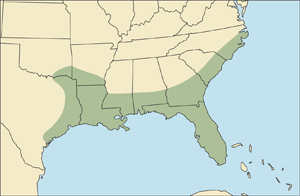 |
Alligator mississippiensis
Lagarto de Mississippi (Sp), Mississippi-Alligator (G), Alligator du Mississippi (F). "Alligator" is derived from the Spanish el lagarto, a lizard. The specific name is for the Mississippi River, where the type specimen was collected.
DESCRIPTION Usual length is 6-12 feet (1.8 to 3.7 m), but 18 feet (5.5 m) is possible.
The American alligator is a lizard-like reptile with a heavy, cylindrical body; large, triangular head; powerful jaws with many conical teeth; short legs with clawed, webbed toes; long massive tail; and thick plated skin (flat plates on belly, keeled plates on back). Eyes, ears and nostrils are on top of the head and can project above water when the rest of the body is submerged. When under water, the nostrils and ears close, a third eyelid protects the eyes, and a flap of skin closes off the back of the mouth, allowing the alligator to eat under water without drowning. Differs from crocodiles in having a shorter, broader snout, with the teeth of the lower jaw fitting inside those of the upper jaw, thus not visible when the mouth is closed. Juveniles are black with yellow bands; adults are a grayish-black all over.
BEHAVIOR Carnivorous, mostly nocturnal, and amphibious. Spends most of its time in the water; however, is known to take rather long overland journeys, and during the day will often sun itself at water's edge, sometimes in large numbers. Otherwise solitary, with individual territories. Feeds mainly on fish, small animals birds, and domestic pets, but sometimes takes larger mammals as well. Digs burrows for shelter. Able to endure colder winters than other alligators/caimans and most crocodiles. A mound-nesting species, with the female building a mound of mud and vegetation in which her eggs (usually 20-70) are buried. The male roars loudly, and both sexes hiss. Usually avoids humans, but attacks (sometimes fatal) do occur. Crocodilians have the most highly developed brains of all reptiles; they often show curiosity and are capable of being tamed to a certain extent.
HABITAT Marsh-bordered lakes and coastal marshes, both freshwater and brackish.
DISTRIBUTION Widespread in wetlands of the southeastern United States from coastal North Carolina westward through the southern parts of South Carolina, Georgia, Alabama and Mississippi; all of Florida and Louisiana; eastern Texas, extreme southern Arkansas, and the southeastern corner of Oklahoma. This is similar to its historic range.
STATUS Severely depleted in the 1950s from loss of habitat, commercial hide-hunting, and persecution as a pest. Since then, protective measures have allowed excellent recovery (for example, in Louisiana from 26,000 in 1957 to over 300,000 in 1982). Total population (1982) about 800,000.
|





